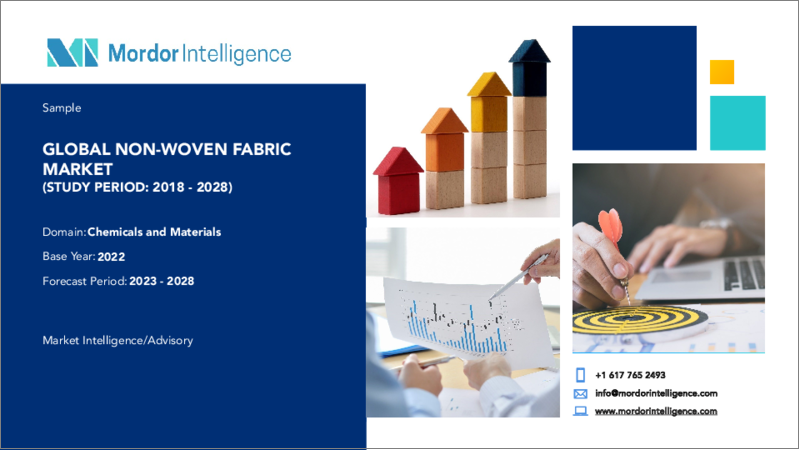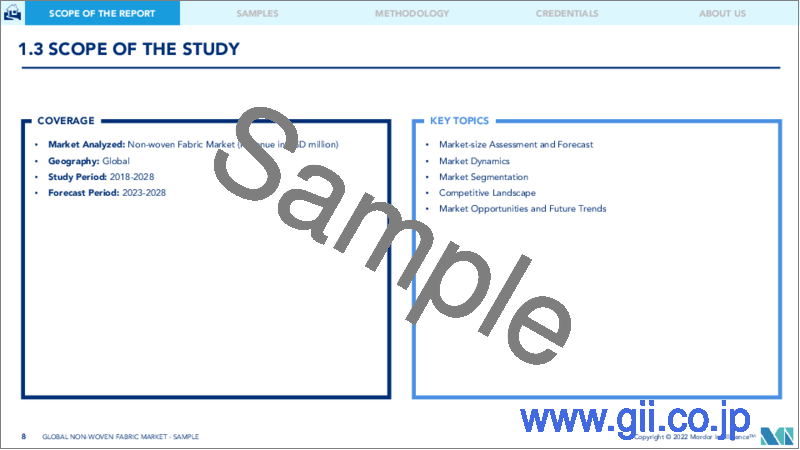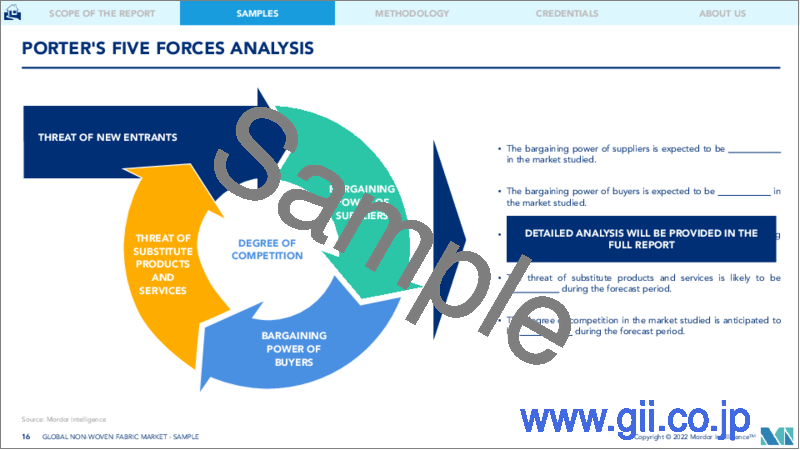|
|
市場調査レポート
商品コード
1197750
不織布の世界市場- 成長、動向、予測(2023年-2028年)Non-Woven Fabric Market - Growth, Trends, and Forecasts (2023 - 2028) |
||||||
|
● お客様のご希望に応じて、既存データの加工や未掲載情報(例:国別セグメント)の追加などの対応が可能です。 詳細はお問い合わせください。 |
|||||||
| 不織布の世界市場- 成長、動向、予測(2023年-2028年) |
|
出版日: 2023年01月23日
発行: Mordor Intelligence
ページ情報: 英文 150 Pages
納期: 2~3営業日
|
- 全表示
- 概要
- 目次
不織布の世界市場は予測期間中、CAGR7%未満で推移すると予測されています。
COVID-19の大流行が不織布市場の成長に与えた影響はわずかでした。政府が中小企業向けの経済対策などを行ったため、世界中の消費者が必需品や個人用保護具に注目するようになりました。
主なハイライト
- 短期的には、ヘルスケアおよびパーソナルケア業界における用途の拡大と、電気自動車の需要増が市場の成長を牽引すると予想されます。
- しかし、不織布の耐久性や強度が低いことが、市場における不織布の需要を阻害する可能性があります。
- 一方、米国やアジア太平洋地域のその他の新興国における建設活動の増加は、不織布市場に将来の機会を提供する可能性が高いです。
- アジア太平洋地域は、不織布の需要が建設、ヘルスケアなどの産業からの増加するアプリケーションと需要によって主に駆動される、世界の市場を独占しました。
不織布の市場動向
ヘルスケア産業からの需要拡大
- 不織布は、手術着、エプロン、ドレープ、マスク部品、創傷被覆材など、ヘルスケア産業におけるさまざまな製品の製造に使用されています。また、生理用タオル、生理用ナプキン、タンポン、ベビー用おむつ、ナプキンライナーなどの衛生用品にも使用されています。
- COVID-19の発生により、ウイルスの拡散を防ぐための不織布製フェイスマスクの需要が大幅に増加しました。このため、世界中で不織布の需要が飛躍的に増加しています。
- アジア太平洋地域では、インドや中国といった国々で女性用衛生用品の採用が進んでいることから、予測期間中に衛生用品の使用が大幅に増加すると予想されています。
- インドでは、現在、インド人女性の60%以上が生理用品を使用していないと推定されています。これは主に、農村部に居住する人口が多いことに起因しています。衛生観念の高まりによる生理用品の普及率の上昇に伴い、同国の不織布市場は急速に拡大すると予想されます。
- Statistaによると、インドでは2021年に生理用ナプキンの販売枚数が103億1,000万枚に達し、過去5年間で100%以上の成長を遂げています。同様に中国でも、衛生面への関心の高まりから、生理用品やベビー用おむつの市場が急成長しています。
- SDMAによると、英国では、創傷管理にかかる総費用は約83億ユーロ(約97億米ドル)と推定されています。そのうちの約67%は治癒していない創傷の管理に費やされており、市場における不織布の需要を潜在的に後押ししています。NHSは毎年、世界の成人人口の約7%(380万人)に相当する患者を治療しています。
- また、主要国による医療施設に対する支出の増加も、ヘルスケア産業の成長をさらに促進し、予測期間中の不織布市場の需要を強化すると予想されます。例えば、OECDによると、米国は過去5年間でヘルスケアへの支出と資金調達が25%増加し、2021年には4兆800億米ドルに達することが示されています。
- その他、人口増加、高齢化の進展、世界のCOVID-19の発生などが、ヘルスケア産業における不織布の需要を押し上げています。
アジア太平洋地域が市場を独占すると予想される
- アジア太平洋地域は、世界最大の消費地となる見込みです。これは、同地域における追加設備の稼働と不織布の生産量の増加に起因しています。不織布の消費量と生産量では、中国が世界最大のシェアを占めています。
- 中国の繊維産業は、第13次5カ年計画による投資と政府支援の増加により、活況を呈しています。同国の繊維・アパレルメーカーは、痛みを伴う産業再編を進めています。例えば、スタティスタによると、2022年10月の繊維生産量は衣料用生地で31億8000万メートルに達しました。
- 中国政府は新疆を繊維・アパレル製造の温床にしようと計画しており、80億米ドルを投資しています。中国北西部は、今後8年間で国内最大の繊維生産拠点になると予想されています。
- 一方、ヘルスケアはインドの最大分野の一つとなっています。政府が医療向上に力を入れていることもあり、同国の医療費の対GDP比は急速に伸びています。2022-23年に発表された連邦予算では、保健家族福祉省(MoHFW)に86,200.65カロールインドルピー(112億8,000万米ドル)が配分されました。
- 前述のすべての要因は、順番に、エンドユーザー産業の急速な成長により、アジア太平洋地域で高い割合で市場を推進すると予測されます。
不織布市場の競合他社分析
不織布市場は断片的で、大小さまざまなプレーヤーが存在します。トップ企業6社で世界市場の22%以上を占めています。市場の主要プレイヤー(順不同)には、Berry Global Inc.、Freudenberg Group、Ahlstrom-Munksjo、KCWW、DuPontなど。
その他の特典
- エクセル形式の市場予測(ME)シート
- アナリストによる3ヶ月間のサポート
目次
第1章 イントロダクション
- 調査の前提条件
- 調査範囲
第2章 調査手法
第3章 エグゼクティブサマリー
第4章 市場力学
- 促進要因
- ヘルスケア産業におけるアプリケーションの増加
- 電気自動車への需要拡大
- 阻害要因
- 生地の耐久性と強度の低さ
- 産業バリューチェーン分析
- ポーターのファイブフォース分析
- 供給企業の交渉力
- 買い手の交渉力
- 新規参入業者の脅威
- 代替品の脅威
- 競合の度合い
第5章 市場セグメンテーション(金額ベース市場規模)
- 技術分野
- スパンボンド
- ウェットレイド
- ドライレイド
- その他の技術
- 素材
- ポリエステル
- ポリプロピレン
- ポリエチレン
- レーヨン
- その他の素材
- エンドユーザー業界
- 建築・土木
- 繊維
- ヘルスケア
- 自動車
- その他のエンドユーザー産業
- 地域別
- アジア太平洋地域
- 中国
- インド
- 日本
- 韓国
- その他アジア太平洋地域
- 北米
- 米国
- カナダ
- メキシコ
- 欧州
- ドイツ
- 英国
- イタリア
- フランス
- その他欧州
- 南米
- ブラジル
- アルゼンチン
- その他の南米地域
- 中東地域
- サウジアラビア
- 南アフリカ共和国
- その他の中東地域
- アジア太平洋地域
第6章 競合情勢
- M&A、合弁事業、協業、契約
- 市場シェア(%)**/ランキング分析
- リーディングプレイヤーが採用する戦略
- 企業プロファイル
- Ahlstrom-Munksj
- Autotech Nonwovens Pvt. Ltd
- Berry Global Inc.
- Cygnus Group
- DuPont
- Eximius Incorporation
- Fitesa
- Freudenberg Performance Materials
- Glatfelter
- Johns Manville
- KCWW(Kimberly-Clark Corporation)
- Paramount Tech Fab Industries
- PFNonwovens Czech SRO
- Toray Industries Inc.
- TWE Group
第7章 市場機会と今後の動向
- アジア太平洋地域と米国における建設活動の活発化
The non-woven fabric market is expected to register a CAGR of less than 7% during the forecast period.
The impact of the COVID-19 pandemic was minimal on the growth of the non-woven fabric market. As governments provided economic packages for SMEs and other benefits, consumers worldwide are now focussing on essential commodities and personal protective equipment.
Key Highlights
- Over the short term, the growing application base in the healthcare and personal care industry, along with increasing demand for electric vehicles, is expected to drive the market studied.
- However, the low durability and strength of the fabric could potentially hamper demand for non-woven fabric in the market.
- On the flip side, increasing construction activities in the US and other emerging economies across the Asia-Pacific region could likely provide future opportunities to the non-woven fabric market.
- Asia-Pacific dominated the market across the world, where the demand for non-woven fabric is majorly driven by the increasing application and demand from industries like construction, healthcare, etc.
Non-woven Fabric Market Trends
Increasing Demand from the Healthcare Industry
- Non-woven fabric is used to make various products in the healthcare industry, such as surgical gowns, aprons, drapes, face mask components, and wound dressings. They are also used in hygiene products, such as sanitary towels, sanitary napkins, tampons, baby diapers, and napkin liners.
- Owing to the COVID-19 outbreak, there has been a huge increase in the demand for non-woven face masks to prevent the spreading of the virus. This has resulted in an increase in demand for non-woven fabrics across the world at an exponential rate.
- Asia-Pacific is expected to witness a significant increase in the use of hygiene products over the forecast period due to the increasing adoption of female hygiene products in countries like India and China.
- In India, it is currently estimated that over ~60% of Indian women do not use sanitary care products. This is majorly due to the high amount of population residing in rural areas. With the increase in the penetration rate of sanitary care products, owing to the increasing hygiene precautions, the market for non-wovens in the country is expected to grow rapidly.
- According to Statista, in India, the sales of sanitary napkins reached 10.31 billion pieces in 2021, growing by over 100% during the last five years. Similarly, in China, the market for feminine products and baby diapers has been growing at a rapid rate due to increasing hygiene-related concerns.
- According to SDMA, in the United Kingdom, the total cost of wound management is estimated to be around EUR 8.3 billion (USD 9.7 billion). Around 67% of it is spent on managing unhealed wounds, potentially driving the demand for non-woven fabric in the market. The NHS manages around 7% of the world's adult population, which is equivalent to 3.8 million patients, every year.
- An increased spending by major economies on the healthcare facilities is also anticipated to further drive growth for the healthcare industry, thereby strengthening demand for non-woven fabric market during the forecast period. For instance, according to OECD, the United States witnessed its healthcare expenditure and financing grow by 25% in the last five years, amounting to USD 4.08 trillion in 2021.
- Other factors like population growth, increasing aging population, and the COVID-19 outbreak across the world are driving the demand for non-woven fabrics in the healthcare industry.
Asia-Pacific is Expected to Dominate the Market
- Asia-Pacific is expected to be the largest consumer globally, owing to the commissioning of additional capacities and an increase in the production of non-woven fabric in the region. In terms of consumption and production of non-woven fabric, China held the largest share globally.
- The textile industry in China is booming, with increasing investments and government support from the 13th Five Year Plan. Textile and apparel makers in the country are going through painful industrial restructuring. For instance, textile production reached 3.18 billion meters of clothing fabric in October 2022, according to Statista.
- The Chinese government is planning Xinjiang as the hotbed for textile and apparel manufacturing, and it has invested USD 8 billion. China's northwest region is expected to become the country's largest textile production base over the next eight years.
- On the other hand, healthcare has become one of India's largest sectors. The country's healthcare spending as a percentage of GDP is growing rapidly, owing to the government's focus on improving healthcare. In the Union Budget announced for 2022-23, INR 86,200.65 crores (USD 11.28 billion) was allocated to the Ministry of Health and Family Welfare (MoHFW).
- All the aforementioned factors, in turn, are projected to drive the market at high rates in the Asia-Pacific region, owing to the rapid growth of end-user industries.
Non-woven Fabric Market Competitor Analysis
The non-woven fabric market is fragmented, comprising several large and small players. The top six players accounted for over 22% of the global market. Major players in the market (not in any particular order) include Berry Global Inc., Freudenberg Group, Ahlstrom-Munksjo, KCWW, and DuPont, among others.
Additional Benefits:
- The market estimate (ME) sheet in Excel format
- 3 months of analyst support
TABLE OF CONTENTS
1 INTRODUCTION
- 1.1 Study Assumptions
- 1.2 Scope of the Study
2 RESEARCH METHODOLOGY
3 EXECUTIVE SUMMARY
4 MARKET DYNAMICS
- 4.1 Drivers
- 4.1.1 Increasing Application in the Healthcare Industry
- 4.1.2 Growing Demand for Electric Vehicles
- 4.2 Restraints
- 4.2.1 Low Durability and Strength of Fabric
- 4.3 Industry Value-Chain Analysis
- 4.4 Porter's Five Forces Analysis
- 4.4.1 Bargaining Power of Suppliers
- 4.4.2 Bargaining Power of Buyers
- 4.4.3 Threat of New Entrants
- 4.4.4 Threat of Substitute Products and Services
- 4.4.5 Degree of Competition
5 MARKET SEGMENTATION (Market Size in Value)
- 5.1 Technology
- 5.1.1 Spun-bond
- 5.1.2 Wet-laid
- 5.1.3 Dry-laid
- 5.1.4 Other Technologies
- 5.2 Material
- 5.2.1 Polyester
- 5.2.2 Polypropylene
- 5.2.3 Polyethylene
- 5.2.4 Rayon
- 5.2.5 Other Materials
- 5.3 End-user Industry
- 5.3.1 Construction
- 5.3.2 Textile
- 5.3.3 Healthcare
- 5.3.4 Automotive
- 5.3.5 Other End-user Industries
- 5.4 Geography
- 5.4.1 Asia-Pacific
- 5.4.1.1 China
- 5.4.1.2 India
- 5.4.1.3 Japan
- 5.4.1.4 South Korea
- 5.4.1.5 Rest of Asia-Pacific
- 5.4.2 North America
- 5.4.2.1 United States
- 5.4.2.2 Canada
- 5.4.2.3 Mexico
- 5.4.3 Europe
- 5.4.3.1 Germany
- 5.4.3.2 United Kingdom
- 5.4.3.3 Italy
- 5.4.3.4 France
- 5.4.3.5 Rest of Europe
- 5.4.4 South America
- 5.4.4.1 Brazil
- 5.4.4.2 Argentina
- 5.4.4.3 Rest of South America
- 5.4.5 Middle-East
- 5.4.5.1 Saudi Arabia
- 5.4.5.2 South Africa
- 5.4.5.3 Rest of Middle-East
- 5.4.1 Asia-Pacific
6 COMPETITIVE LANDSCAPE
- 6.1 Mergers and Acquisitions, Joint Ventures, Collaborations, and Agreements
- 6.2 Market Share (%)**/Ranking Analysis
- 6.3 Strategies Adopted by Leading Players
- 6.4 Company Profiles
- 6.4.1 Ahlstrom-Munksj
- 6.4.2 Autotech Nonwovens Pvt. Ltd
- 6.4.3 Berry Global Inc.
- 6.4.4 Cygnus Group
- 6.4.5 DuPont
- 6.4.6 Eximius Incorporation
- 6.4.7 Fitesa
- 6.4.8 Freudenberg Performance Materials
- 6.4.9 Glatfelter
- 6.4.10 Johns Manville
- 6.4.11 KCWW (Kimberly-Clark Corporation)
- 6.4.12 Paramount Tech Fab Industries
- 6.4.13 PFNonwovens Czech SRO
- 6.4.14 Toray Industries Inc.
- 6.4.15 TWE Group
7 MARKET OPPORTUNITIES AND FUTURE TRENDS
- 7.1 Increasing Construction Activities in the Asia-Pacific Region and United States




